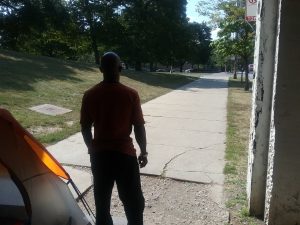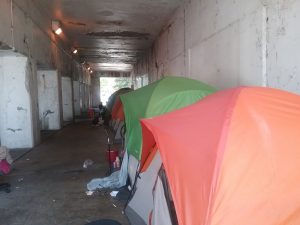Chicago’s homeless lose viaducts as home turf
By Kevin Beese Staff Reporter — September 18, 2017
Lucky, a homeless individual living in the Wilson Avenue viaduct at Lake Shore Drive in Chicago, looks west from under the underpass. Lucky, who asked that his full name not be used, said chasing individuals from LSD viaducts will be an issue for many individuals. (Photo by Kevin Beese/Chronicle Media)
Homeless individuals are no longer calling the Lake Shore Drive viaducts at Lawrence and Wilson avenues home as the city of Chicago has begun restoration work on those underpasses.
A federal judge ruled last week that the tents under the viaducts that are used by homeless individuals are not a protected First Amendment statement as homeless advocates had argued. U.S. District Court Sidney Shenkier ruled that the city viaduct work could begin this week as planned and that the homeless living under those viaducts needed to depart.
The city has said it would ensure that all the homeless under those viaducts who want to stay in a shelter have access to one.
Work was slated to begin on the viaducts Monday morning. Results of how that deadline was met by the homeless were unavailable as of press time.
Homeless advocates had argued that many of the homeless do not feel safe in local shelters and would rather be on the street.
With rules changing from shelter to shelter, some homeless who do try to find temporary housing can have problems adjusting from one shelter to another, one expert said.

A posted notice tells homeless individuals that they will have to depart from the viaducts. (Photo by Kevin Beese/Chronicle Media)
“Each shelter has its own rules,” Doug Ryan, a licensed social worker who has worked with the homeless, testified at last week’s hearing to attempt to stop the city from chasing the homeless from the viaducts. “People with mental illness can’t cope with that. Even high-functioning individuals can have problems with that. Shelters aren’t for everyone.”
Ryan said there is a distinct difference between a social worker’s approach to homeless individuals and the city’s approach.
“A social worker will meet a person where they are at,” Ryan said. “The city will meet the person where they are at to tell them to leave.”
Maggie Sobota, an attorney for the city, pointed out during Thursday’s court proceedings that the city has guaranteed that there are enough beds available in shelters to handle the homeless from the viaducts. The viaduct work is scheduled to go on until spring.
Sobota also pointed out that the number of homeless in the city overall and in the Uptown neighborhood (where the Lawrence and Wilson viaducts are) has decreased in the past year.
Homeless advocates say they are not confident in city numbers. They note that the Coalition for the Homeless estimates that there are 120,000 homeless in the city while the city in its annual one-day count of the homeless said it could only find 5,800.

Tents are set up under the Wilson Avenue viaduct at Lake Shore Drive last week. City work on that viaduct and the one at Lawrence Avenue means homeless individuals will not be able to stay under the underpasses this fall, winter and spring. (Photo by Kevin Beese/Chronicle Media)
Andy Thayer, a member of the Uptown Tent City Organizers, which works on behalf of the homeless, said police have cited incorrect city ordinances to justify their chasing of homeless individuals from the viaducts.
“These are ordinances that do not allow you to park a vehicle or carriage on top of viaducts and bridges,” Thayer said.
He said the city has yet to address the problem of homelessness despite promises from Chicago Mayor Rahm Emanuel to do so.
“There is a systemic lack of housing for people,” Thayer said. “… I am concerned homeless won’t have a place to go.”
Read the current issue of the Cook County Chronicle
Free subscription to the digital edition of the Cook County Chronicle
— Chicago’s homeless lose viaducts as home turf —-



